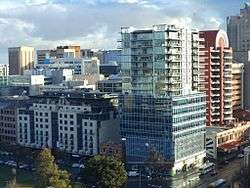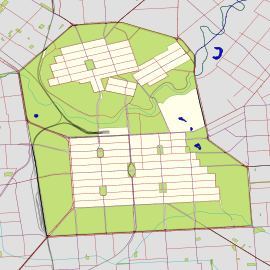Hindmarsh Square
Hindmarsh Square/Mukata (formerly Mogata) is one of five public squares in the Adelaide city centre, South Australia. It is located in the centre of the north-eastern quarter of the city, and surrounds the intersection of Grenfell and Pulteney Streets, near the eastern end of the Rundle Mall. Pirie Street forms the southern boundary of the square.
| Hindmarsh Square | |
|---|---|
| Mukata | |
 High-rise developments, SW corner of Grenfell St, 2012 | |
 | |
| Type | Square |
| Location | Adelaide, South Australia, Australia |
| Coordinates | 34.9241°S 138.6057°E |
| Created | 1837 |
It is one of six squares designed by the founder of Adelaide, Colonel William Light, who was Surveyor-General at the time, in his 1837 plan of the City of Adelaide which spanned the River Torrens Valley, comprising the city centre (South Adelaide) and North Adelaide. It was named after John Hindmarsh, the first Governor of South Australia, in the same year by the Street Naming Committee, and in 2003 assigned a second name in the language of the original inhabitants, Kaurna, Mogata (later changed to Mukata), as part of the dual naming initiative by the Adelaide City Council.
History
The square was first named by the street naming committee on 23 May 1837 after Governor Hindmarsh.[1][2]
The east side of the square was for many years dominated by the Congregational Church,[3] which later became the orchestral studio for ABC Radio and the South Australian Symphony Orchestra at No. 44, with other studios in adjacent buildings (48–56) and a rehearsal studio and recording facilities across the Square in the ground floor and basement of Football House (No. 55).[4]
The building then named CitiCentre, on the north-western side of the square, was the scene of the high-profile murder of psychiatrist Margaret Tobin in 2002.[5]
In March 2003, as part of the City of Adelaide's dual naming project in association with the University of Adelaide's project, the square was assigned the name "Mogata", from the Kaurna word Mukarta, meaning "head".[6] The spelling was later changed to Mukata. This was the name of one of the four wives of Mullawirraburka, a Kaurna elder and warrior, also known as "King John". Mukata was also known as "Pretty Mary".[7]
In 2018, two charging stations for electric vehicles were created in Hindmarsh Square, as part of a citywide plan which created a total of 46 EV stations across the city centre.[8]
See also
- Hurtle Square/Tangkaira
- Light Square/Wauwi
- Victoria Square/Tarntanyangga
- Whitmore Square/Iparrityi
- William Light
References
- "Nomenclature of the Streets of Adelaide and North Adelaide" (PDF). State Library of South Australia. Retrieved 14 December 2019.
taken from The City of Adelaide Year Book, 1939-1940
Cite journal requires|journal=(help) - "History of Adelaide Through Street Names". History of South Australia website. Archived from the original on 14 June 2008. Retrieved 25 July 2008.
- Obituary South Australian Register Saturday 31 January 1874 Supplement p.7 accessed 28 October 2011
- Directory of South Australia Sands & McDougall, Adelaide, 1962
- Lynton Grace (11 January 2014). "The most notorious crimes that shook and horrified South Australia: Margaret Tobin 2002". The Advertiser (Adelaide). Retrieved 17 May 2019.
- "Kaurna Placename Meanings within the City of Adelaide". University of Adelaide. Kaurna Warra Pintyanthi. 27 November 2019. Retrieved 28 November 2019.
- "City squares recognise women from the past". City of Adelaide. 19 March 2018. Retrieved 28 November 2019.
- "46 Electric Vehicle Charging Stations Now Available Across the City of Adelaide". City of Adelaide. 14 September 2018. Retrieved 28 November 2019.
Further reading
- Hems, Owen. "Hindmarsh Square / Mukata". Adelaidia.